All Things Necessary in My Artistic Journey
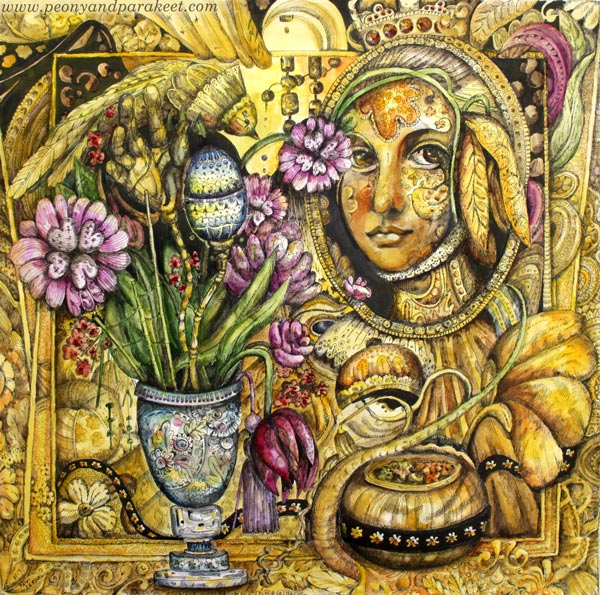
Here’s my recent drawing called “All Things Necessary.” It’s inspired by the discoveries that I made while building the class Magical Inkdom. When I taught IT professionals back in the 1990s, we teachers used to say that you learn best when you teach a class. We had to constantly learn new technologies, and it made us professionals not only in teaching but also in learning.
However, some things take time, and even if trying to find the best ways to work with both ink and watercolor enabled this piece, the idea behind it goes much further back in my artistic journey, to the year 2014.
A Great Idea but Not So Great Execution from 2014
I have archived many of the old blog posts because back in 2014 I wasn’t very good at writing, and the posts are too short for the search engines. But I found the blog post in my personal archive and here’s what I wrote back in 2014:
“I often get these ideas that cost a million. Like the big painting that shines in gold and silver. It would look like a reproduction of the beautiful doors I saw last year when visiting the Hermitage Museum, in St. Petersburg, Russia. Someday I will make it! So I made a small prototype. It is a wooden block that is covered with all kinds of stuff found in my crafting space.”
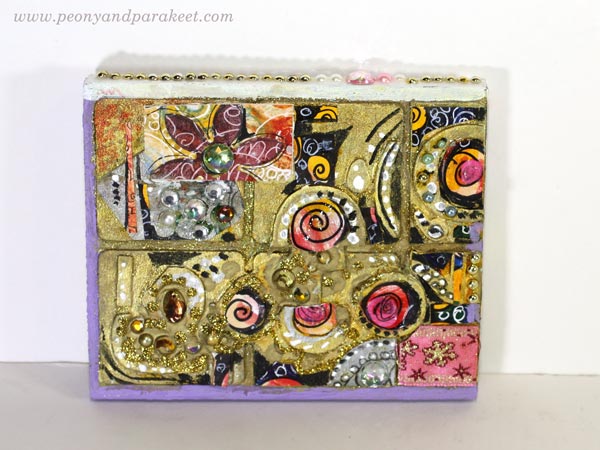
This idea has haunted me since I made this crafty block, or I could say since I visited St. Petersburg, Russia. I have two blurry photos from that trip that I look at quite often. One is the golden door and the other is a handpainted plate at The State Russian Museum.
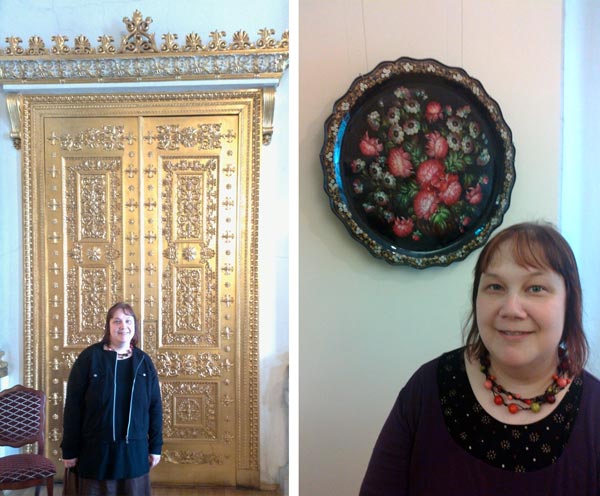
I felt I had found the aesthetics that I also wanted to create. First, I thought I would literally need real gold. Here’s how I ended the blog post:
“So, if you follow me, then you know what I will do if I win in a lottery! Real gold, jewels … wow, it will look astonishing.“
I wish I could turn back time, and say to myself: “Don’t lose this idea! Keep creating, and once your skills will grow, you will find the way.”
Dumping the Idea – “It’s Too Superficial”
The problem with me has been that when my skills haven’t met my vision, I have let go of the ideas around it. I have said to myself:
– “It wasn’t what I wanted to create anyway.”
– “It was too superficial, I want to create deeper stuff.”
– “The idea was great but not what other people would want to see”
– “Only rich and overly successful people could do that.”
– “There will be new and better ideas that are easier to execute.”
And so I have felt lost many times in my artistic journey because I haven’t been able to re-create that golden door, my true desire.
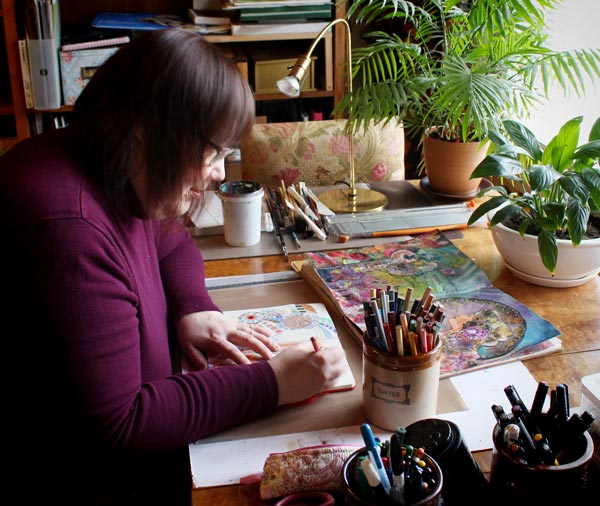
Getting Back to the Idea with More Skills
But for Magical Inkdom, I wanted to create gold. There my main message has been that we can make the wrong right, and define what’s magical to us. So I drew some golden frames, and they looked magical! (Instructions will be published in Lesson 4.)
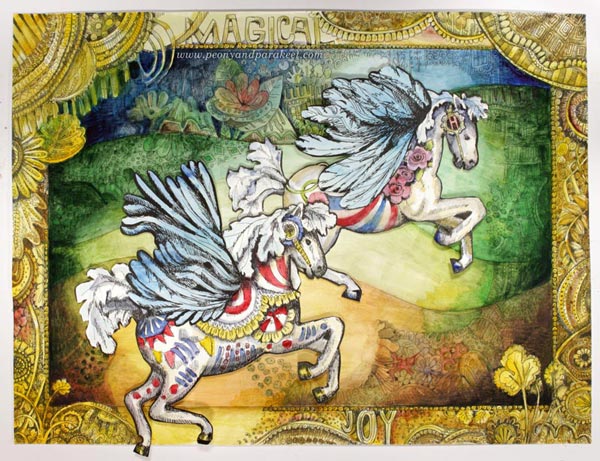
Of course, I couldn’t just have a little bit of gold and settle with that. So I began a new piece, approximately 18 by 18 inches. It’s the biggest ink drawing that I have made so far. I knew my skills are there. I didn’t need a sketch or a prototype but just pour out everything that I love.
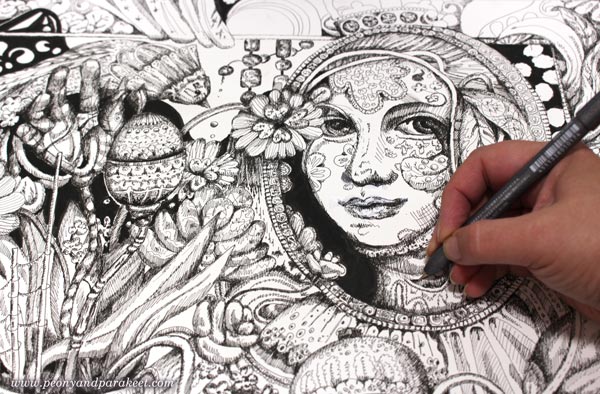
While I colored the drawing with watercolors, I thought about the appropriate title. The most accurate that came to my mind was “Kaikki tarpeellinen” meaning “All Things Necessary”. This kind of golden luxury may seem unnecessary and even overwhelming to many, but it’s necessary for me. I need to load this daily into my mind to keep my zest for life alive.
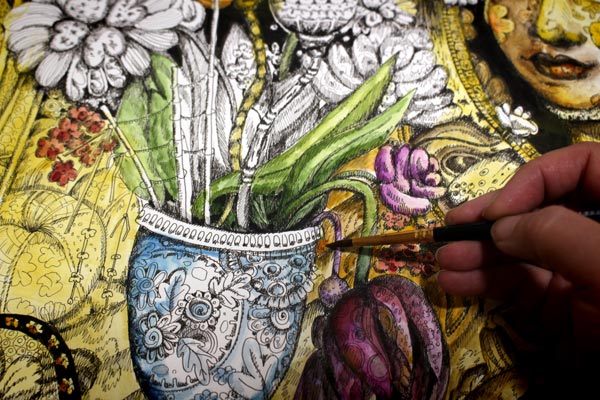
All Things Necessary: It’s a world where Salvador Dali travels to the Rococo era, and then back and forth between the Renaissance age and the 20th century.
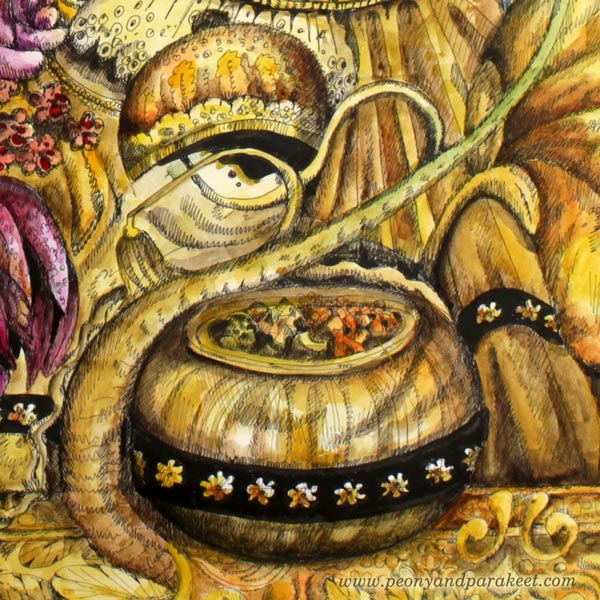
It’s a world where golden birds lay Faberge eggs and land on golden fingers.
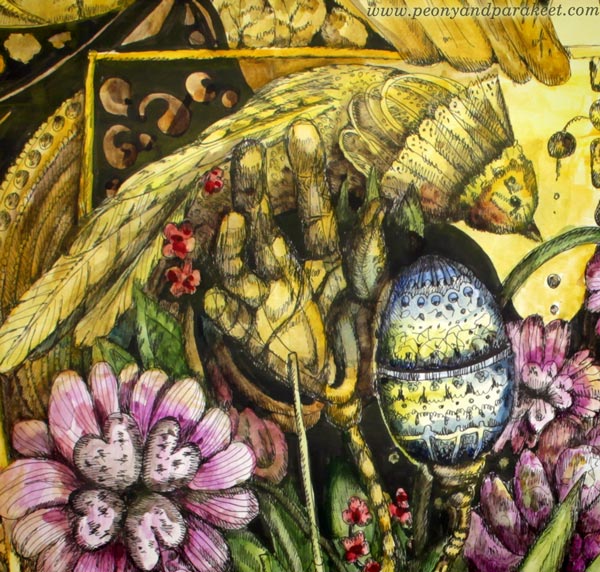
It’s a world where people, animals, and physical items share the same qualities and play the same symphony.
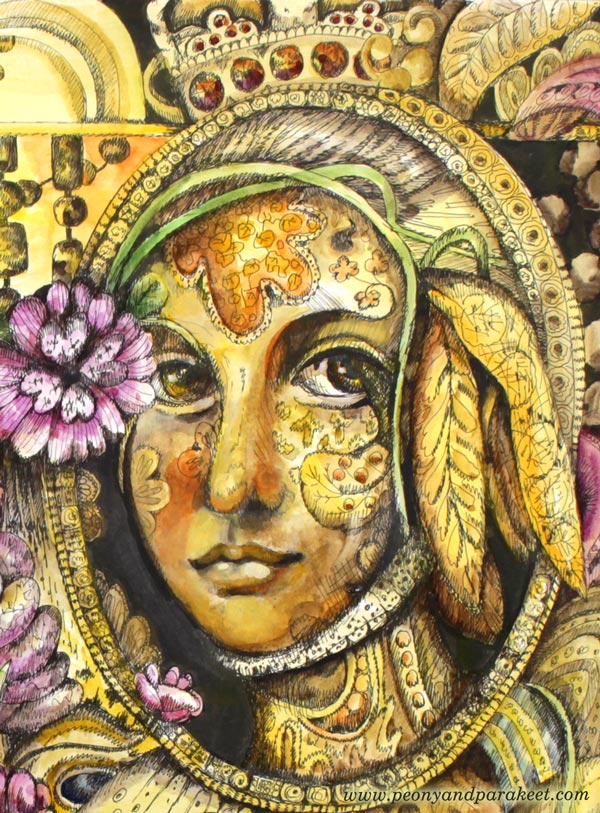
It’s a world where a cembalo plays a bit too loud, where all the gold hurts your eyes, and where the chaos is suspiciously acceptable.
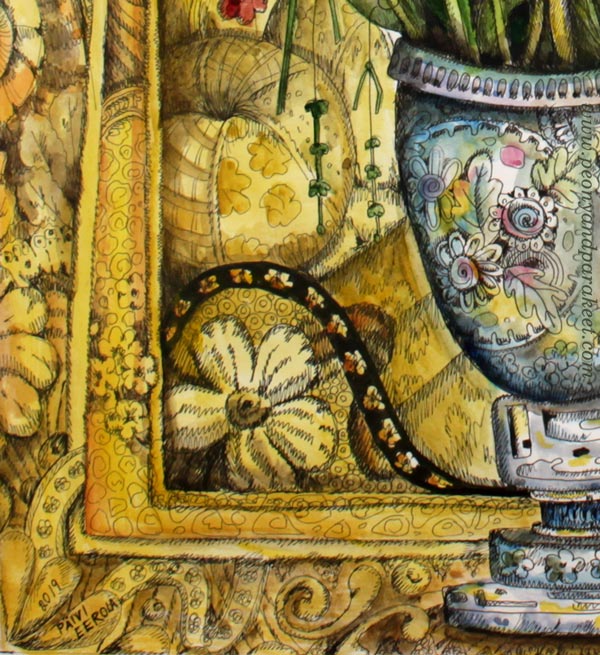
It’s the same place that I was trying to find in 2011, when I was madly drawing circles, and when some of you started following this blog.
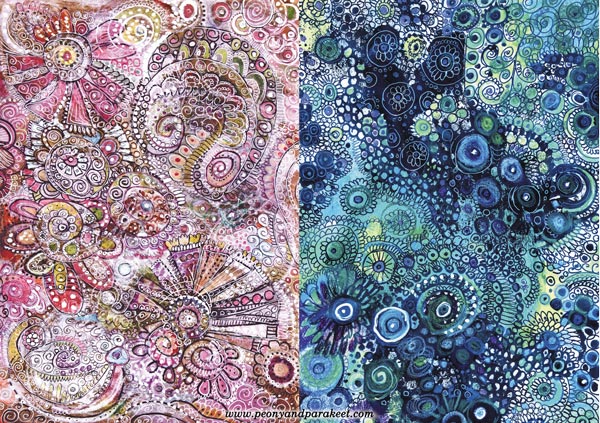
All Things Necessary for Moving on in the Artistic Journey
This new piece has made me re-think about the whole discussion about the artistic journey and finding a visual voice. I have blogged a lot about it, coached people for it, but it’s not easy to dig out a quiet seed that needs a lot of time and care to grow. Our artistic vision, the road sign, can be an ugly “prototype” like my old craft project that we carelessly toss away!
Let’s hold on to the things that keep deeply touching us while growing our skills in drawing and painting.
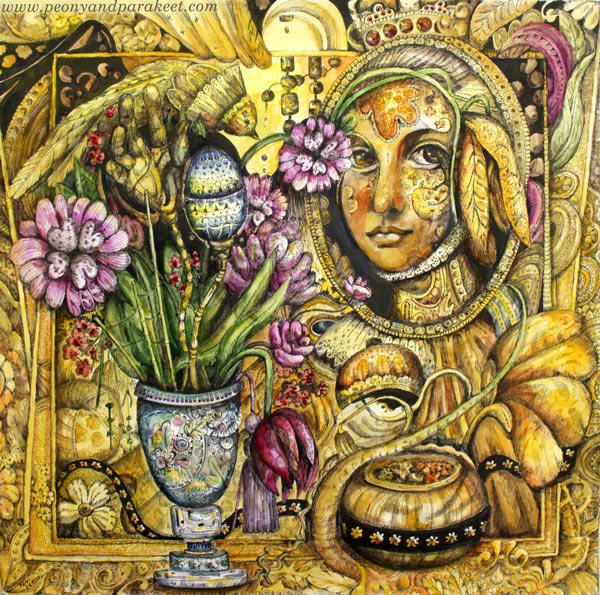
Come to draw fantastic art with me – Sign up for Magical Inkdom!
Right after the registration, you will get all the lessons published so far, and you are good to start drawing! >> Sign up here!
Varnishing, Framing, and Celebrating Your Best Paintings
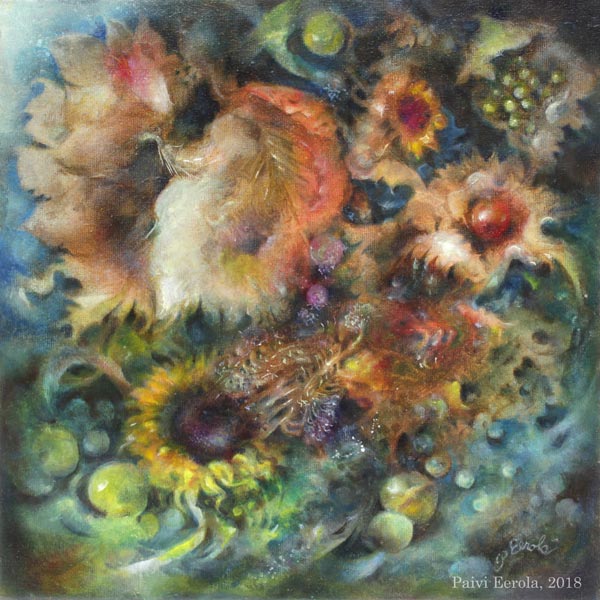
I have finished an oil painting called “Temptation.” I started it at the beginning of this year and after tens of painting sessions and weeks of drying time, I finally got it finished, varnished, and framed. So it’s time for celebration! So, the theme for this blog post is our best work, and especially our best paintings.
I have been planning this post for well over a year to get all the images I want to show you, and the experiences that I want to share with you, so I am happy that with the latest painting, the time has come for this article too!
Best Work – How to Know?
In art, there are very few absolute rights and wrongs, so this question can have many answers. But here’s how I know when I have produced my best work:
1) Time: I have worked on the painting for tens of hours and tens of sessions. Even if some artists work quickly, in general, most people underestimate the time that professional artists spend with their pieces. Overworking is rarer than underworking!
2) Message: I know why the painting exists. I can start a painting without a specific idea in mind, but when the painting progresses, I need to find a connection and a story to be able to make all the decisions needed.
3) Details: I have paid attention to every area of the painting. Some areas can be freer or less detailed than others but they have to be aligned with the overall message of the painting, supporting the most important areas.
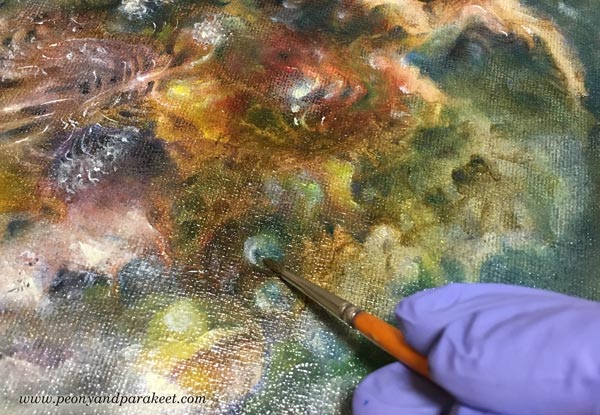
Best Work – Test!
I have a couple of tests that I always use for my best work. Try these!
A) Do you want to hang your painting on your wall?
Here, I mean your painting, on your wall in your home. When I use this test, I don’t imagine anyone else’s home or anyone else’s wall. If I don’t want the painting on the wall, it’s likely that no one else will either.
B) Do you see your painting as a treasure?
Place the painting on the table, walk away from the room, and then come back and glance at it. If your instant reaction is that there’s a valuable item on the table, the painting is close to the finish. Here, the difficult thing is that you need to recognize your reaction quickly and glance at the painting from a distance. The further away you can be and get the impression of a treasure, the better. When I use this test, I try to alienate myself from the painting before entering the room.

When you have produced a painting that meets your criteria, why not varnish, frame and celebrate it?! These are all important steps to me. Let’s start with varnishing!
Before Varnishing – Take Photos!
Varnishing makes the painting harder to photograph because it will have glares more easily. If you have produced your best work, you will also want to get good photos of them! I use a tripod when taking photos, and if the weather is good, I take the photos in natural light.
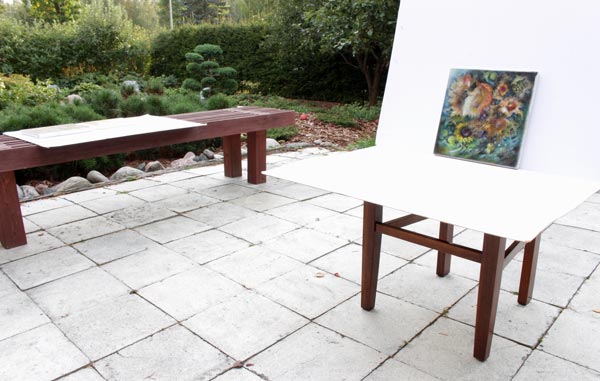
Varnishing an Oil Painting – The Traditional Way
Oil paintings are tricky to varnish because they dry slowly. The drying time depends on how thick the layers are and how much drying time there has been between them. In any case, it’s months, and it can be more than a year! With “Gypsy Madonna,” I waited for nine looooong months. Every layer had dried a week or more, and they were very thin, so based on the advice that I got, that would be enough.
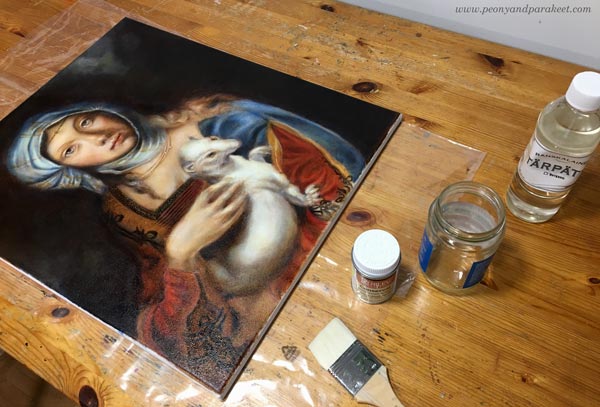
I bought Rublev Conservar Dammar Gloss Varnish with UV protection and applied it with a broad and soft goat bristle brush.
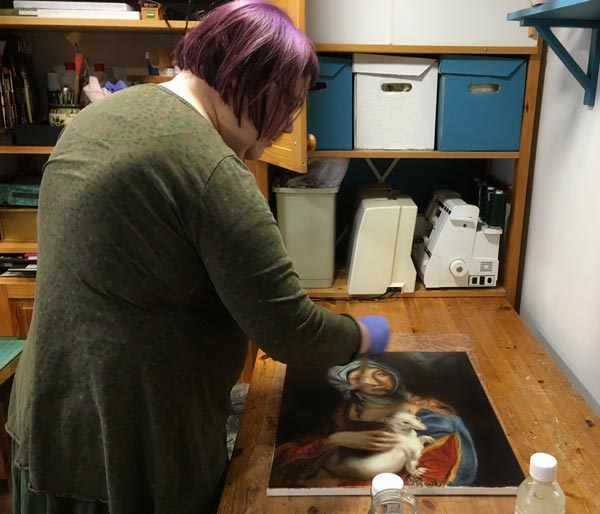
Always when varnishing, it’s good to:
1) double-check and follow the instructions of the specific product that you use. Don’t rely on the instructions that come with the bottle but go to the manufacturer’s website to see if there’s more advice.
2) apply a small amount of varnish and keep the layer thin.
3) let the previous varnishing layer dry properly before adding a new layer. Usually, a couple of layers are needed.
4) if possible, reserve a brush for varnishing only
Varnishing an Oil Painting – A Quick Solution
Luckily, there’s an alternative for traditional oil varnishes. It’s called Gamvar Picture Varnish. I got to know about it from my artist friend Eeva Nikunen. She has also made a process video about using Gamvar.
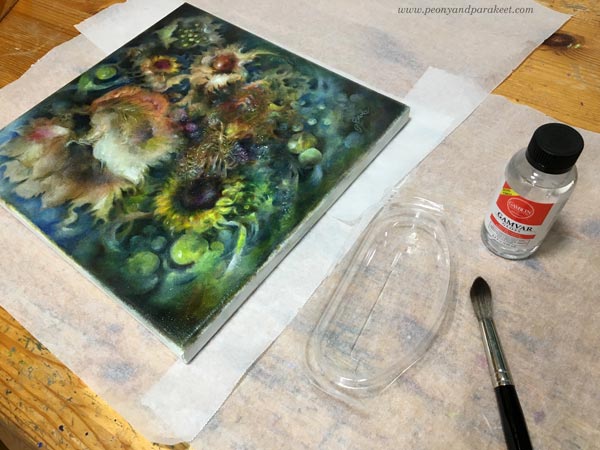
This medium only requires the surface to feel dry. So it can be applied after a few weeks after finishing the oil painting. I used Gamvar for the first time now, and because it’s thicker, it’s much easier to handle than the traditional varnish. Spreading Gamvar is more like rubbing with small strokes than painting with long strokes. A little sturdier brush works better here. I used a watercolor brush.
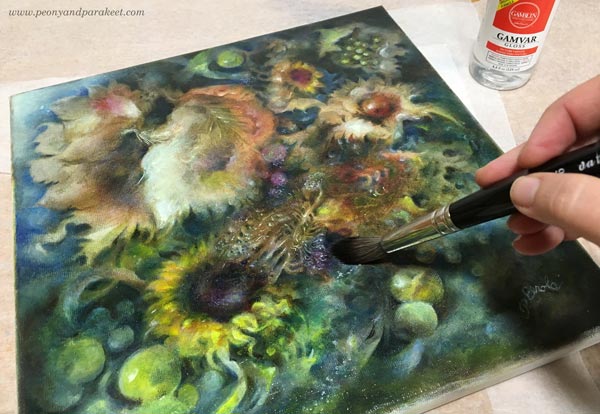
The pleasure of varnishing is the same regardless of the medium. The colors become more vibrant, and the painting begins to shine. I prefer using glossy to matte varnishes because I love the extra glow!
Varnishing an Acrylic Painting
Varnishing is not just for oil paintings! You can varnish acrylic paintings as well, just remember that they have their own products. I mostly use Golden acrylic paints, so when varnishing acrylic paintings, I have also used products of the same brand.
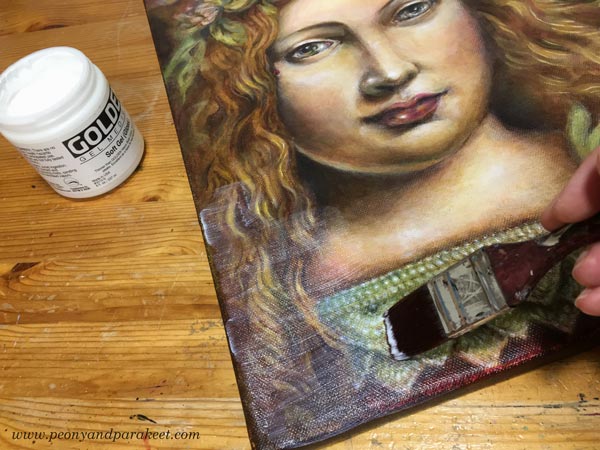
First, I add a layer or two of gel medium (Golden Soft Gel Gloss) before I begin the varnishing. Gel medium separates the paint layers from the varnishing layer. I mix some water with the gel medium to make it more fluid so that the brush strokes don’t show so well. I use a broad and flat brush and let every layer dry before adding a new one. It’s good to wait at least a day because polymer products can feel dry even if they haven’t dried properly yet.
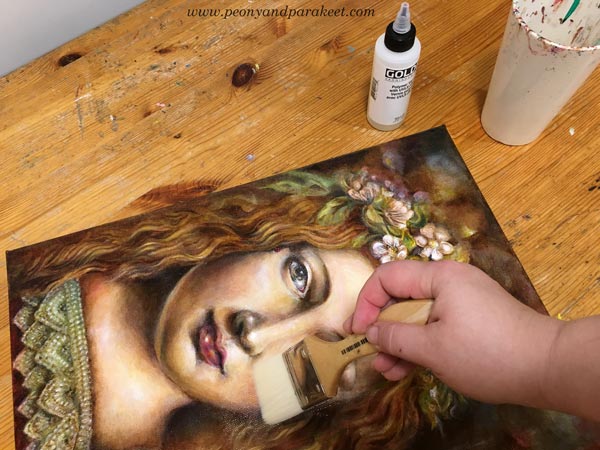
Then I add 1-3 layers of Golden’s glossy polymer varnish. It has to be mixed with water, and every layer has to dry 3-6 hours before adding a new one. I try not to put too much pressure on the brush so that the brush strokes won’t show.
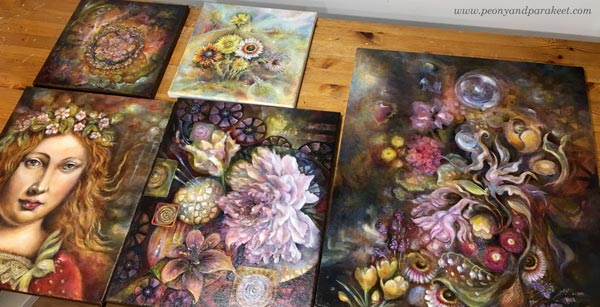
I think that after varnishing, the increase of the vibrancy is as visible as with oil paintings. Definitely worth the effort!
Celebrating the Finished Painting – Framing
If my opinion, the best way to celebrate the finished painting is to get it framed. If varnishing is the makeup, framing is the dress. The impact of the frame is incredible when it fits well and continues the personality of the painting. Sorry about the glare in the sample images!
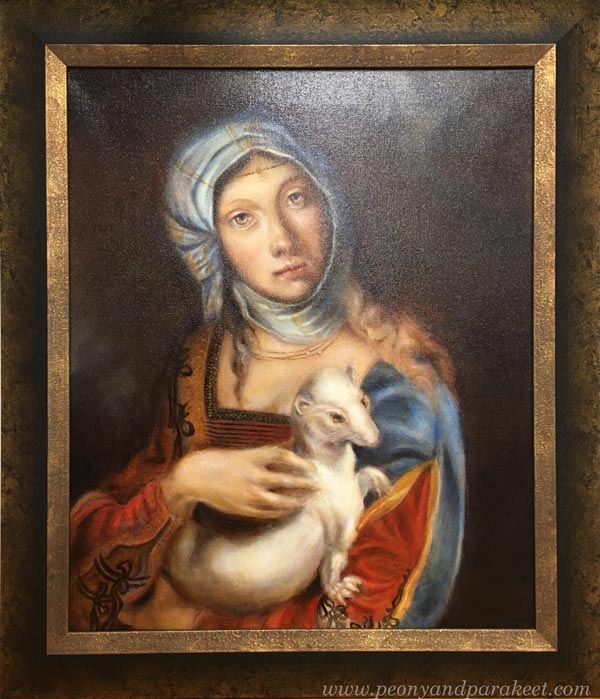
I use a local professional framer because I love the quality. I chose an old-fashioned and heavy frame for the Renaissance-style painting, and it made it look like an old masterpiece. Without frames, the image was much more modest.
For this acrylic painting, I chose a dark frame that makes the colors shine.
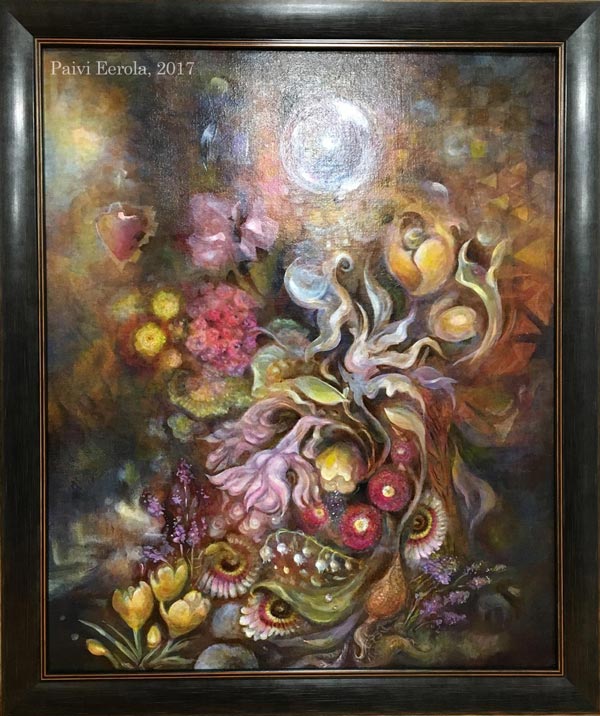
If the frame were lighter, the dark colors of the background would have got more attention, and the result wouldn’t be as harmonic.
Today, I got “Temptation” from the framer. Because this painting is like a collection of treasures, I wanted the frame to be luxurious too.
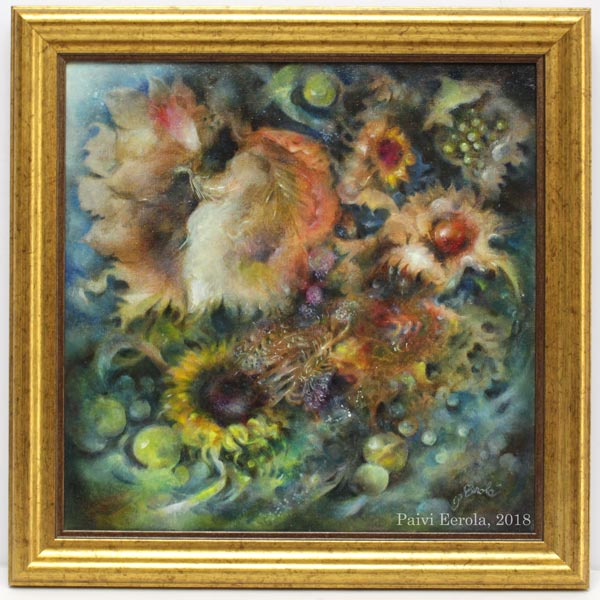
Celebrating the Finished Painting – Music!
I also like to celebrate my best pieces by listening to some music when admiring them. I try to find a song that is aligned with the painting and it’s often a song that I have already listened when working on the piece. For “Temptation”, the song is Musetta’s aria from Puccini’s opera “La Boheme”. After exposing the painting to the critical eye for so long, it’s time to forget the struggles and enjoy the accomplishment. I find this combination of musical and visual pleasure one of the best joys in life.
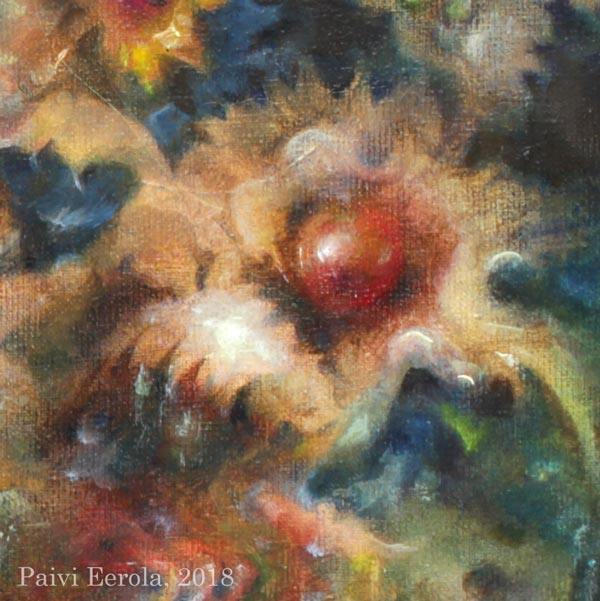
I hope you too will celebrate your best work!
P.S. “Temptation” is now available in my art store, see more detailed photos there!
Resilience, Interview of Eeva Nikunen, and a New Class!
Lots have happened this week! I hope you enjoy these videos!
Resilience to Create a Big Project – Interview of Eeva Nikunen
This week, I interviewed fantasy artist Eeva Nikunen about her big project – creating a self-published book from her art. We are talking about resilience: what she has learned from creating a series from her visual dreamland and how she has been able to carry through the project all by herself. Eeva also shows the supplies that she has been using, and if you are curious about graphite pencils, this episode is truly inspiring!
New Class: Collageland!
I am excited to launch a new class called Collageland! It is a new, expanded version of an old mini-course that I made for 21 Secrets in 2015. It’s packed with inspiration from textiles and instructions on how to create handmade collage art. See the video below!
New Live Next Week: Discover Your Style by Building a Visual Dreamland
Rather than trying to succeed and capture your style through a single project, start exploring your creativity as a process, designing your visual dreamland one stroke at a time! I will talk about my newest class Collageland and what I learned in 2009-2015 when moving from crafts to design and from design to art.
Come meet me live next week, May 10, 2018, 5 PM BST (London), 9 AM PDT (San Francisco) >> Reserve Your Spot here!
Painting a Series – How I Managed It!
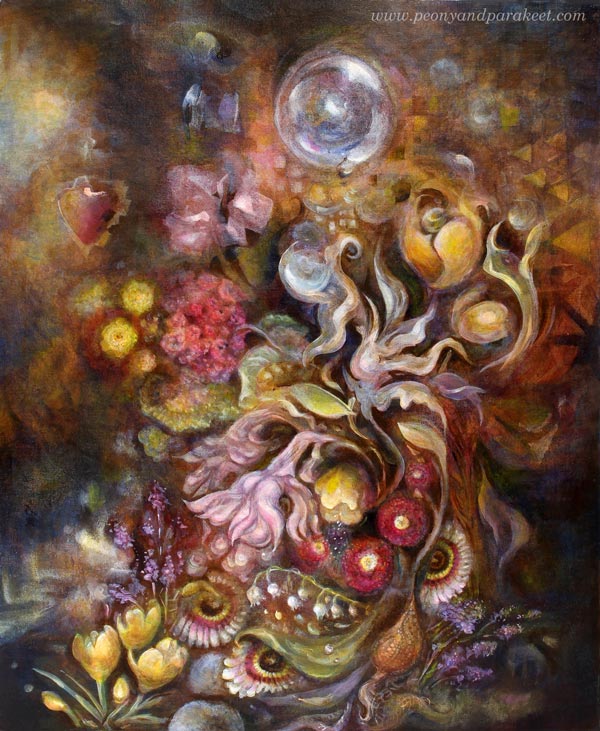
I have just finished a series of five flower paintings on canvas. Yesterday, when I was walking back and forth from my studio to the rest of the house, preparing for the photography and the varnishing, I felt both relieved and terrified. I was relieved because nine months of hard work was at the end. I felt terrified because I had run out of excuses for delaying the start of a new series.
Technique Came First, Themes Second
But let’s get back to early spring when I was painting the first of the five paintings. My goal was to master old masters’ painting technique in acrylics so that I could teach it. I had no idea of how many pieces it would require. Before teaching, I needed to understand “why” not just “how.” I also had to develop a logic that makes learning possible, variations that show the possibilities of the technique, and the systematic way of working to make everything as understandable and to the point as possible.

When I was painting Strawberry Madonna, it soon became clear to me that I was nowhere near to be teaching the technique. I needed to fix my strokes constantly. Even if the fixing doesn’t show in the finished painting, it became clear that I needed more practice. I couldn’t fuss around that way while teaching.
So I bought new canvases and kept on painting. I made experiments, art journal pages, and had several paintings in progress at the same time. I focused on painting what I wanted to include in the class as well: flowers and playing with historical styles. Crafts like crochet, decorative painting, jewelry, fabric, etc were also sources of inspiration. Most of the pieces took tens of hours from me to finish. The quickest is “Four Seasons” that I recorded for the class. With the final touches added after the recording, it took less than ten hours to paint. “Queen of Fantasy” took much longer. You can see me starting it in the free video, but I adjusted the painting many times after that.
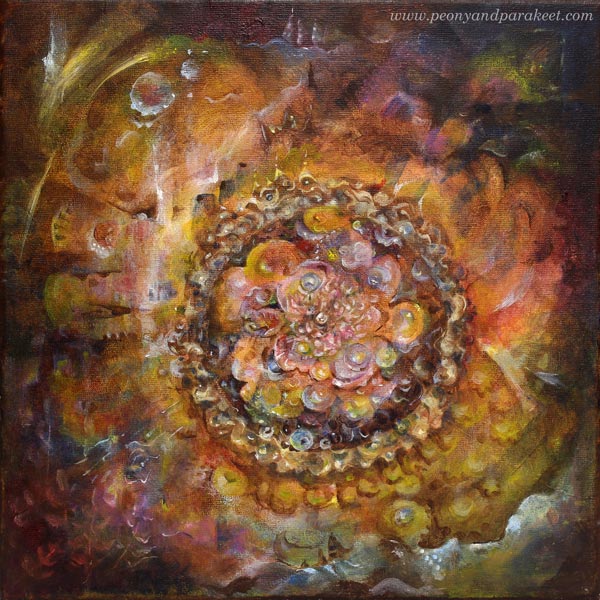
Painting a Series – The Most Important Insight
The funny thing about all this is that I wasn’t intentionally painting a series. Working towards the goal of mastering and understanding the old masters’ technique, gave direction to my work. If I had thought about the series more intentionally, I would have probably freaked out! Now when I look back, the most important thing to me was that I expressed the power of flowers in all my paintings but thought about it differently in all the five paintings.
- For “Living Treasure” I got ideas from gardening.
- “Strawberry Madonna” connects flowers with fruits and their taste.
- “Queen of Fantasy” is about flowers representing romance.
- “Blooming Centuries” tells how flowers have always inspired painters, designers, and crafters.
- “Four Seasons” shows sisu, a Finnish word for resilience when you work against all the odds and still find the spirit to bloom and prosper.
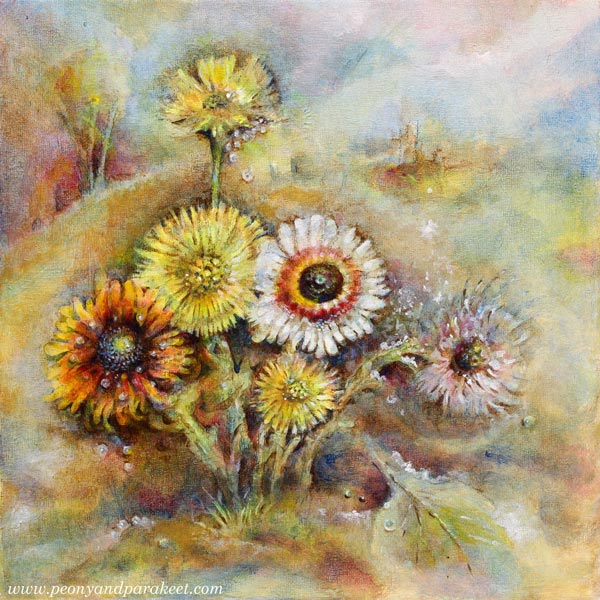
So I had a set of generic themes that were repeated in all the paintings, but different interpretations of them. That made them work as a series but so that they don’t look identical at all. Being very intentional about the series and prohibiting new ideas emerge while working can lead to a very boring result and in my case, it would probably make me quit because the lack of excitement and adventure that keeps me going.
I think this insight could also be useful for those who seek for their style. Rather than painting the same thing and get bored by it, find bigger themes and use your creativity to approach them from different angles.
New Era – New Series
During the past couple of months, I have felt fear when thinking where I want to go with my art. I have contemplated that can I share my plans or just keep them hidden because it’s likely that I will fail. For quite some time, I have felt the need to paint abstract art that plays with textures and geometry. I think many of the paintings of this series already have some of that.
I have a funny name for the style of the new series. It is “kinetic-romantic abstract realism.” “Kinetic” means that I want to include movement that is related to machines. “Romantic” means that I want to express through beauty and relationships. “Abstract Realism” refers to the idea of mimicking realistic surface materials for abstract shapes. Very odd, I know, and it terrifies me.
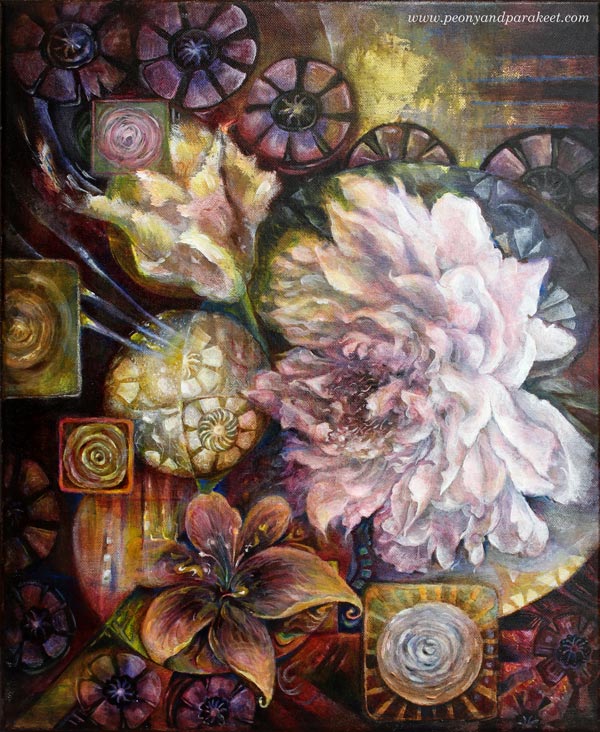
Creativity is a Living Treasure – Watch the Video!
Before the new beginning, it’s time to celebrate the finished series. I have made a short video of the five pieces and the thoughts that came to my mind when painting them. Hopefully, you’ll enjoy the video!
My Painting on Your Wall?
These paintings are also for sale!- Buy them directly from me here!
